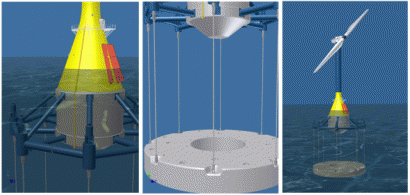
The ETI describes itself as being “tasked with developing ‘mass scale’ technologies that will help the UK meet its 2020 and 2050 energy targets,” and it is taking the challenge seriously. Last month, it announced plans to invest up to £25m in an offshore wind floating system demonstration project, which it hopes “would open up new areas off the coast of the UK and help bring generation costs down”.
It is estimated that the UK has over a third of the total European potential offshore wind resource – enough to power the country nearly three times over. Exploiting this natural resource economically, particularly in deeper waters off the west of the country, will require significant technology developments to build, operate and support large offshore wind arrays. Developing floating platforms on which to site offshore turbines will be an essential part of this work.
“Our national energy systems modelling and our engineering design projects have shown that offshore wind could play a major role in providing clean, secure and affordable energy for the UK and will be an important part of the energy mix by 2050 alongside nuclear power, fossil fuel power stations fitted with carbon capture and storage and large scale energy efficiency measures,” comments Dr David Clarke, ETI Chief Executive.
“Offshore wind must be affordable and cost competitive with alternatives and although large, floating turbines will have high capital costs, they can access near-to-shore, high wind speed sites off the west coast of the UK which overall brings down the cost of electricity generation for the long term. “Our studies have shown that access to high wind areas which are close to shore should be an attractive investment compared to some existing UK sites which are further from the coast in areas of lower wind. We also expect there is likely to be a considerable global market for floating wind turbines which can be developed in the UK.
“We see floating turbine technology being strategically important to both the UK’s energy supply and its industrial strategy which is why we are now seeking partners to carry out the development, installation and commissioning of a full scale floating wind turbine system demonstrator by 2016.”
For waters over 60 metres deep
The project will see the design, construction and installation of a floating system demonstrator by 2016 at a relatively near shore site with high wind speeds up to about 10 metres per second in water between 60 and 100 metres deep. It will be operated for at least two years to show it can generate high levels of electricity, be maintained without using specially designed vessels and to verify the predicted technical and economic performance. The intention is that it would be operated for another eight years to allow further developments to take place.
The ETI will also commission a test site for the demonstrator with possible sites being provided to project participants during the design phase.
Participants chosen to take part in the project will be capable of providing an offshore wind turbine in the 5MW to 7MW range that can be installed on the foundation. A Request for Proposals was issued on 25 October for organisations wanting to get involved in the project. The deadline for the notification of intention to submit a proposal is 6 January 2012 and the closing date is 27 January 2012. A project briefing event will be in December 2011 for organisations wanting to know more about the project.
The ETI has announced £133 million of investments in projects covering marine energy, distributed energy, buildings, energy storage and distribution, carbon capture and storage, transport and bioenergy, including £43 million in offshore wind.
A project to develop blades high-performance blades over 90 metres long for the next generation of large offshore wind turbines is currently being commissioned and an announcement on who will carry out the work on behalf of the ETI will be made early next year.
[Photo: Floating turbine concept being developed by the Uk company Blue H Group Technologies Ltd, operating out of the Netherlands.]
For additional information:

